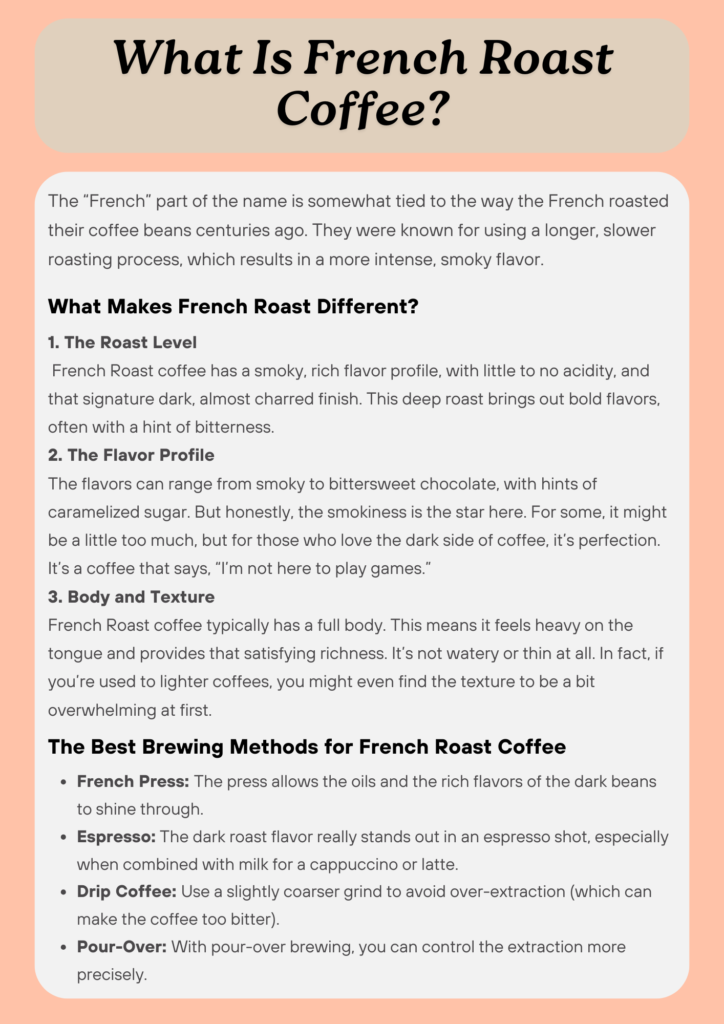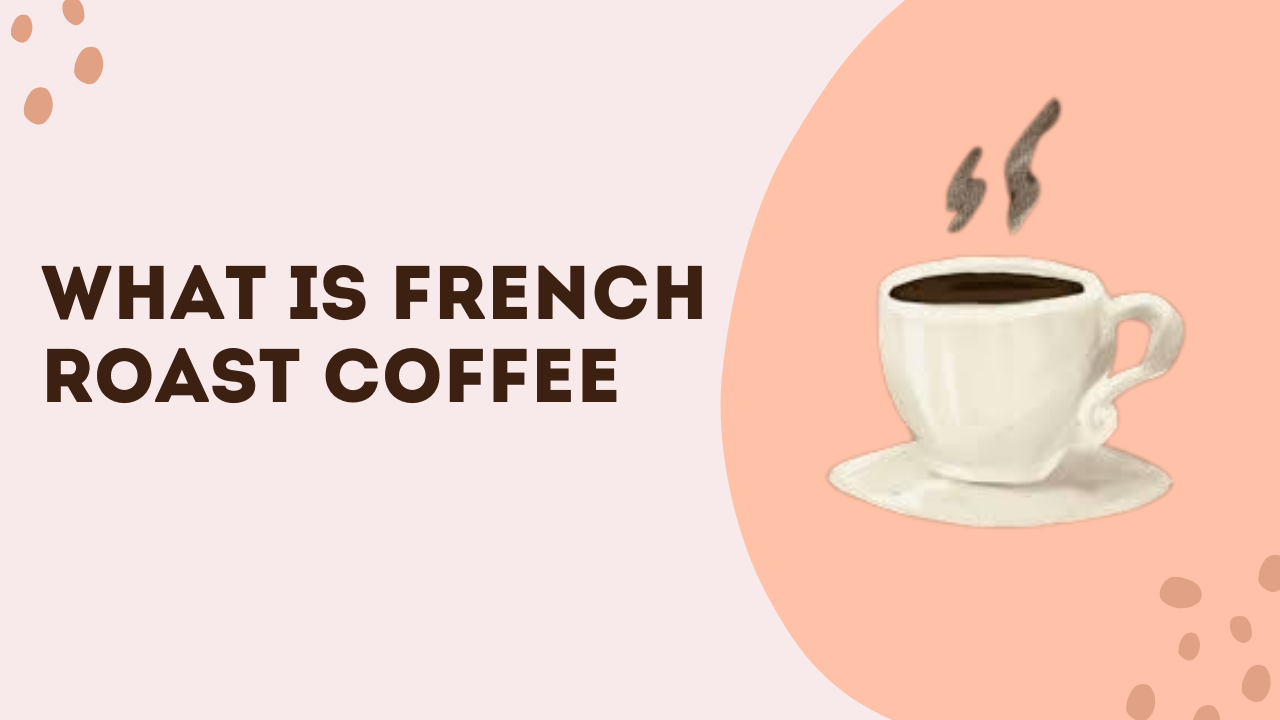If you’ve ever strolled into a coffee shop and seen a variety of coffee roast options on the menu, you’ve probably noticed “French Roast” listed as one of the choices. But what exactly is French Roast coffee, and why does it have such a bold reputation? Let me tell you, it’s more than just a name—it’s a whole vibe, a coffee experience, and a go-to for those who love their cup dark, bold, and slightly smoky.
Whether you’re a coffee connoisseur or just curious about expanding your coffee knowledge, understanding French Roast coffee is like uncovering a hidden gem in the world of brewing. So grab your favorite mug and let’s dive into everything there is to know about French Roast coffee!
Table of Contents
The Origins of French Roast Coffee
Now, first thing’s first: despite the name, French Roast coffee doesn’t necessarily originate from France. I know, shocking, right? The term “French Roast” is more about the roast level than the geographical origin of the beans. Coffee beans labeled as “French Roast” are usually roasted to a much darker level than, say, a light roast or medium roast.
The “French” part of the name is somewhat tied to the way the French roasted their coffee beans centuries ago. They were known for using a longer, slower roasting process, which results in a more intense, smoky flavor. Over time, as the popularity of dark coffee grew, especially in places like the U.S., the French Roast became synonymous with the darker end of the coffee roasting spectrum.

What Makes French Roast Different?
If you’ve ever tried a French Roast, you probably noticed it’s much darker and more intense than a regular coffee. But let me break it down a bit further for you.
1. The Roast Level
French Roast coffee is roasted to the “second crack” stage. In the roasting process, coffee beans first “pop” when they hit a certain temperature (that’s the first crack). But when they continue roasting past that point, they hit the second crack, which is when they start to get darker and take on an oily sheen. The result? French Roast coffee has a smoky, rich flavor profile, with little to no acidity, and that signature dark, almost charred finish. This deep roast brings out bold flavors, often with a hint of bitterness.
2. The Flavor Profile
Let’s talk about the taste for a minute—because honestly, if you’re going to go for a French Roast, you wanna know what you’re getting into, right? When you sip on a French Roast, you’ll probably notice that it’s bold. I mean, it’s not subtle at all. The flavors can range from smoky to bittersweet chocolate, with hints of caramelized sugar. But honestly, the smokiness is the star here. For some, it might be a little too much, but for those who love the dark side of coffee, it’s perfection. It’s a coffee that says, “I’m not here to play games.”
3. Body and Texture
French Roast coffee typically has a full body. This means it feels heavy on the tongue and provides that satisfying richness. It’s not watery or thin at all. In fact, if you’re used to lighter coffees, you might even find the texture to be a bit overwhelming at first. But don’t worry, it’s just the nature of a dark roast. It’s the coffee equivalent of a heavyweight contender—strong, thick, and ready to take on the day.
What Does French Roast Coffee Pair Well With?
Now that we’ve talked about the flavor, let’s consider what kind of food might be the perfect sidekick for your French Roast coffee. A cup of French Roast can be pretty intense, so it pairs well with equally strong-flavored foods. Think dark chocolate, croissants with jam, or even rich desserts like tiramisu. You can also pair it with hearty breakfast foods like bacon and eggs. The richness of the coffee complements the savory notes of these dishes.
If you like your French Roast a little less intense, try adding a splash of milk or a spoonful of sugar to mellow out the bitterness. But, hey, that’s totally up to you—there’s no wrong way to enjoy it!
The Best Brewing Methods for French Roast Coffee
While you can brew French Roast coffee using any method, certain techniques bring out its bold flavors even more. If you’re a fan of that smoky depth, here are a few methods to consider:
- French Press: This method is almost too perfect for French Roast. The press allows the oils and the rich flavors of the dark beans to shine through. Just make sure you don’t overbrew, or you might end up with a bitter cup.
- Espresso: French Roast coffee is often used in espresso-based drinks. The dark roast flavor really stands out in an espresso shot, especially when combined with milk for a cappuccino or latte.
- Drip Coffee: If you’re making French Roast with a drip coffee maker, use a slightly coarser grind to avoid over-extraction (which can make the coffee too bitter).
- Pour-Over: With pour-over brewing, you can control the extraction more precisely. For French Roast, aim for a slightly faster pour to prevent over-brewing.
Is French Roast Coffee Right for You?
This is where the subject gets a little more personal. French Roast coffee is definitely not for everyone. If you’re someone who enjoys lighter roasts or fruity, acidic flavors, then French Roast might feel a little too strong for your taste. But if you love bold, smoky, and intense flavors, it might be your new go-to brew.
You might also want to think about your tolerance for caffeine. Although French Roast coffee typically has slightly less caffeine than lighter roasts (since the roasting process burns off some caffeine), it can still pack a punch in terms of its taste and strength.
Conclusion
At the end of the day, French Roast coffee is all about boldness. Whether you’re brewing it at home or ordering it at your favorite coffee shop, you’re in for a strong, smoky cup of coffee that’s far from shy. The dark roast brings out rich, bittersweet flavors that are perfect for those who enjoy a coffee that can stand up to their day—strong, full-bodied, and with a little bit of that roasted kick. So, next time you’re on the hunt for a coffee that’s anything but ordinary, give French Roast a try. Who knows? It just might become your new favorite cup.
